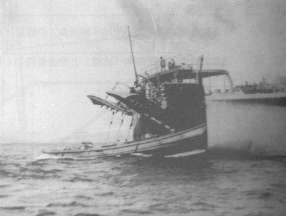Name Shinshū Maru Commissioned 15 November 1934 Construction started 8 April 1933 Length 144 m | Laid down 8 April 1933 Fate Sunk 3 January 1945 Launched 14 March 1934 | |
 | ||
Displacement 7,100 tons standard, 8,108 tons full | ||
Shinshū Maru (神州丸) was a ship of the Japanese Imperial Army during World War II. She was the world's first landing craft carrier ship to be designed as such, and a pioneer of modern-day amphibious assault ships. During some of her operations, she was known to have used at least two cover names, Fuso Maru, and Ryujo Maru.
Contents
The Shinshū Maru was one of the ships sunk by friendly torpedo fire at the Battle of Sunda Strait, but later salvaged and returned to service.
Design features
Shinshū Maru was a significant advance in amphibious warfare, having incorporated numerous innovative features, and as such she was shrouded in a veil of secrecy throughout her existence. She could carry 29 Daihatsu-class landing craft, 25 Shohatsu-class landing craft and four armoured gunboats, to be launched from a floodable well deck.
In addition, it was planned that Shinshū Maru should carry aircraft in a hangar within her voluminous superstructure. The aircraft would have been launched by two catapults to support amphibious assaults, but the catapults were removed before completion and the ship never carried any operational planes.
These concepts pioneered by Shinshū Maru persist to the current day, in the U.S. Navy's LHA and LHD amphibious assault ships.
Fate
On 3 January 1945, while returning to Takao after a supply mission to Leyte Island, Shinshū Maru was heavily damaged by a US air attack by Task Force 38; after the ship was abandoned she was sunk by the submarine USS Aspro in the Formosa Straits off Takao.
